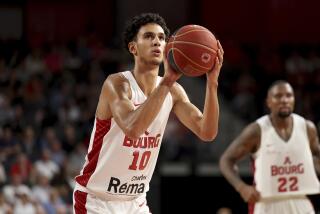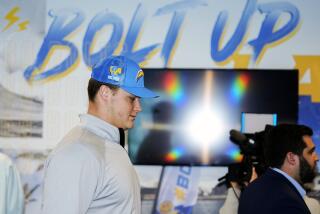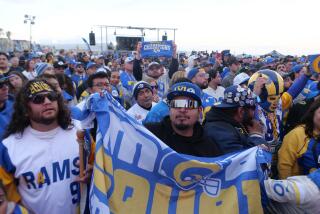Draft Looks Like a Line-Up
- Share via
It was a Carson Palmer coronation.
The USC quarterback, introduced two days earlier as the No. 1 pick of the Cincinnati Bengals, made his way onto the Madison Square Garden stage Saturday, stared into a lightning storm of flashbulbs, and officially began the next chapter of his life.
He adjusted the jacket of his Italian suit and pulled his mesh Bengal cap low over his eyes, looking part L.A. and part Cincitucky. The moment offered all the intrigue and unpredictability of a presidential convention.
Then, the real NFL draft began.
There were trades, twists, gambles, and entire franchises sleeping on the clock. The first round featured defensive linemen almost by the dozen, precious few linebackers, and one running back who might have been a top pick had he not shredded his knee.
The first three rounds took place Saturday, and the final four will be conducted today.
Twenty years after the greatest quarterback class in league history -- an opening round that included John Elway, Jim Kelly and Dan Marino -- the primary focus Saturday was finding players to knock quarterbacks loopy. A record 11 defensive linemen were selected in the first round, beginning with Kentucky tackle Dewayne Robertson, whom the New York Jets grabbed with the fourth pick by trading up with Chicago.
Because Detroit had also considered drafting Robertson at No. 2, the Jets couldn’t breathe easy until after the Lions selected Michigan State receiver Charles Rogers. The Houston Texans, who picked third, were going to draft a receiver either way; they took Miami’s Andre Johnson.
When the Lions drafted Rogers, the reaction of Jet defensive coordinator Ted Cottrell told the story.
“I was yelling and screaming,” he said. “Jumping up and down. I was kind of excited.”
The Minnesota Vikings were considerably less enthused about the way their draft began. They were supposed to pick seventh, but an embarrassing delay caused them to slip two spots when the 15-minute clock expired on them.
They eventually got the player they wanted, Oklahoma State defensive tackle Kevin Williams, but they risked losing him because they were embroiled in trade talks until the very last moment. They were hoping to trade down for more picks, and talked with Jacksonville and New England about doing so before striking a deal with Baltimore. The Vikings submitted the deal to the league in time, but the Ravens didn’t, so the agreement fell through.
In the meantime, Jacksonville and Carolina -- who were to draft eighth and ninth -- quickly made their picks before the Minnesota contingent could regroup. Finally, the exasperated Vikings made their selection.
“It’s all a poker game,” said James Harris, personnel director for Jacksonville, which used its first pick on Marshall quarterback Byron Leftwich. “We were all just playing poker.”
In that case, the Buffalo Bills were the high rollers of the day. They needed a defensive lineman more, but they used the 23rd pick to select Miami running back Willis McGahee, who tore three knee ligaments in the BCS championship game in January and only recently has begun running again.
McGahee, who played two seasons for the Hurricanes, would have been a top-five pick had he not suffered the injury. He has said he can gain at least 1,000 yards this season, and his agent said he’s bound for the Pro Bowl.
Others say McGahee probably won’t make a huge early contribution, however, and needs to prove his knees can hold up to the rigors of live play.
That Buffalo used a first-round pick on him is especially surprising because the Bills already have Travis Henry, who rushed for 1,438 yards and 13 touchdowns last season, and former Denver running back Olandis Gary.
“They caught me off-guard with that pick, but I’m really happy,” said McGahee, who last week worked out in front of nearly 100 coaches, scouts and reporters. “I actually cried. I didn’t want to cry.”
Coach Gregg Williams said there’s a possibility the Bills will put McGahee on the physically-unable-to-perform list, which would give them the option of activating him between weeks 10 and 14 of the season.
“People are talking about, is he going to be ready for training camp?” Williams said. “I don’t care if he’s ready for training camp. It could be late in the year. And we shouldn’t count him out.”
Just about every other team is looking for immediate production, especially from the top picks. The Lions see Rogers as an ideal complement to last year’s first-round pick, quarterback Joey Harrington. Not only is Rogers a local celebrity, but he runs the 40-yard dash in less than 4.3 seconds and has been compared to Randy Moss.
“All the great teams have at least one guy that when he walks on the field you go, ‘We’ve got to put up with him,’ ” Lion CEO Matt Millen said. “That’s what we hope Charles Rogers can do.”
Three picks later, in his first draft as coach of the Dallas Cowboys, Bill Parcells selected Kansas State cornerback Terence Newman, who won the Jim Thorpe Award as the nation’s top defensive back. He can also return punts and play receiver.
Pittsburgh traded up with Kansas City from No. 27 to 16 and selected USC safety Troy Polamalu, who was coveted by several teams.
Arizona State defensive tackle Terrell Suggs, once thought to be a top-five pick, slipped a bit on the heels of two bad workouts and was taken at No. 10 by Baltimore.
Two more quarterbacks went in the first round -- California’s Kyle Boller to Baltimore at No. 19, and Florida’s Rex Grossman to Chicago at No. 22 -- and Texas’ Chris Simms lasted until the final pick of the third round, where Tampa Bay made him the 97th selection. He’s the son of former New York Giant quarterback Phil Simms.
More to Read
Go beyond the scoreboard
Get the latest on L.A.'s teams in the daily Sports Report newsletter.
You may occasionally receive promotional content from the Los Angeles Times.











